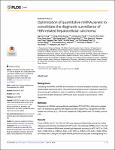Optimisation of quantitative miRNA panels to consolidate the diagnostic surveillance of HBV-related hepatocellular carcinoma
Tat Trung, Ngo
Duong, Dang Chieu
Tong, Hoang Van
Hien, Tran Thi Thu
Hoan, Phan Quoc
Bang, Mai Hong
Binh, Mai Thanh
Ky, Thai Doan
Tung, Nguyen Lam
Thinh, Nguyen Tien
Sang, Vu Viet
Thao, Le Thi Phuong
Bock, Thomas
Background:
Circulating microRNAs (miRNA) are biomarkers for several neoplastic diseases, including hepatocellular carcinoma (HCC). We performed a literature search, followed by experimental screening and validation in order to establish a miRNA panel in combination with the assessment of alpha-fetoprotein (AFP) levels and to evaluate its performance in HCC diagnostics.
Methods:
Expression of miRNAs was quantified by quantitative PCR (qPCR) in 406 serum samples from 118 Vietnamese patients with hepatitis B (HBV)-related HCC, 69 patients with HBV-related liver cirrhosis (LC), 100 chronic hepatitis B (CHB) patients and 119 healthy controls (HC).
Results:
Three miRNAs (mir-21, mir-122, mir-192) were expressed differentially among the studied subgroups and positively correlated with AFP levels. The individual miRNAs mir-21, mir-122, mir192 or the triplex miRNA panel showed high diagnostic accuracy for HCC (HCC vs. CHB, AUC = 0.906; HCC vs. CHB+LC, AUC = 0.81; HCC vs. CHB+LC+HC, AUC = 0.854). When AFP levels were ≤20ng/ml, the triplex miRNA panel still was accurate in distinguishing HCC from the other conditions (CHB, AUC = 0.922; CHB+LC, AUC = 0.836; CHB+LC+HC, AUC = 0.862). When AFP levels were used in combination with the triplex miRNA panel, the diagnostic performance was significantly improved in discriminating HCC from the other groups (LC, AUC = 0.887; CHB, AUC = 0.948; CHB+LC, AUC = 0.887).
Conclusions:
The three miRNAs mir-21, mir-122, mir-192, together with AFP, are biomarkers that may be applied to improve diagnostics of HCC in HBV patients, especially in HBV-related LC patients with normal AFP levels or HCC patients with small tumor sizes.
Files in this item

